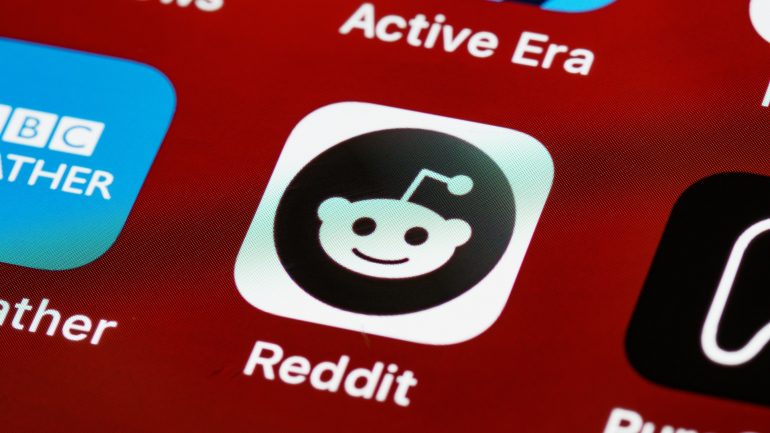SmileDirectClub (NASDAQ: SDC), a Nashville-based oral health company, has caught the attention of Reddit’s WallStreetbets investing forum. The notorious short-squeezing retail army believes they may have found the next GameStop (GME) or AMC Entertainment (AMC) in SDC. Smile Direct Stock has overtaken Tesla and Alibaba to become the most talked-about company on the WSB forum over the last week, with almost 1,400 mentions. Of course, this alone does not indicate whether Smile Direct will go up. However, WSB has nearly 11 million users, and when combined, they wield considerable buying power. Therefore, forum sentiment is an essential factor in determining if a stock has short-squeeze potential.
Below, we analyze and discuss several key metrics to help investors decide whether SDC will live up to the forum hype.
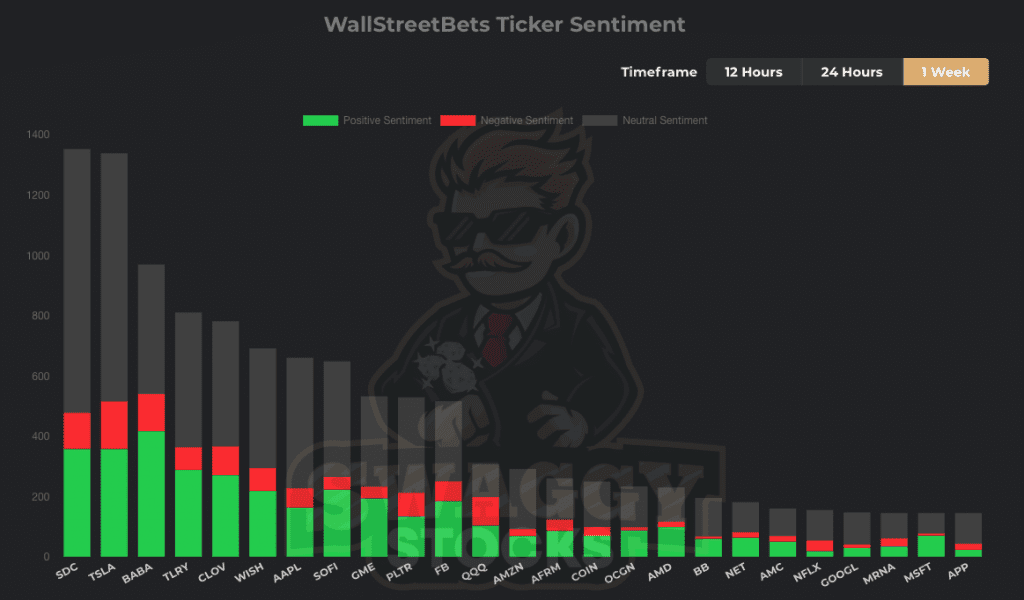
Declining Share Price
First and foremost, for a stock to have squeeze potential, it must be unloved and trading close to 52-week lows and SDC certainly fits the bill. Smile Direct stock has had a torrid time of it in 2021 so far. SDC started the year trading at $12.00, reaching a 2021 high of $16.08 in January. Currently, the stock is trading at $6.00, down 50% year-to-date and 62% below the January high.
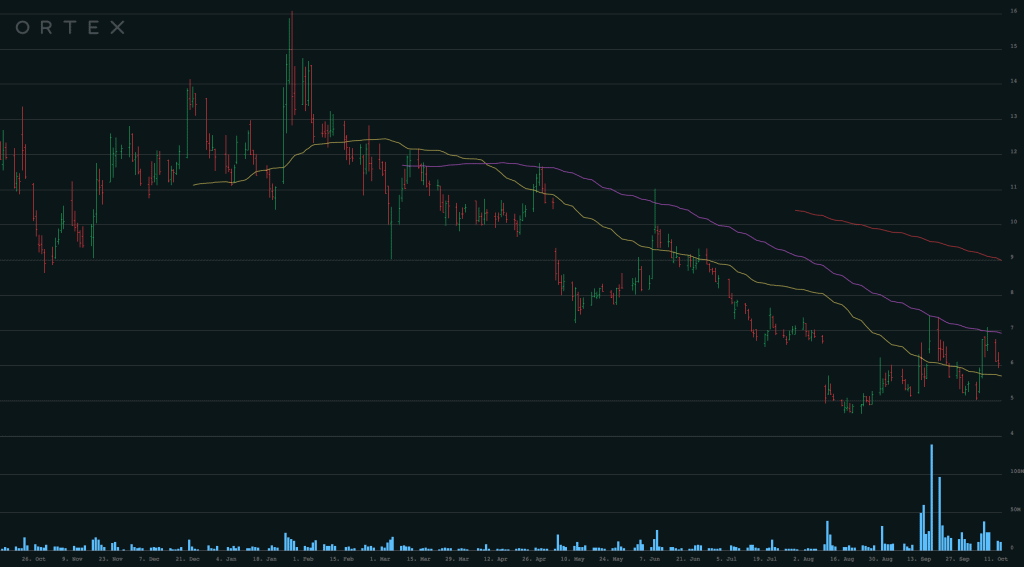
Low Investor Expectations
Smile Direct’s most recent earnings came in below analyst expectations, leading to several banks downgrading the stock.
Earnings for the second quarter of 2021 showed a loss of -$0.14 per share, vs -$0.09 estimates (-55.60%). However, Revenue rose to $174m vs the same period in 2020, although it fell well short of the expected $198.5m. As a result, the consensus wall street rating has lowered from ‘buy’ to ‘hold’.
Weak trading updates and analyst downgrades are significant because existing shorts become comfortable with their positions. Furthermore, negative coverage often encourages new sellers into the stock, strengthening the resolve of the bulls.
Increasing Short Interest
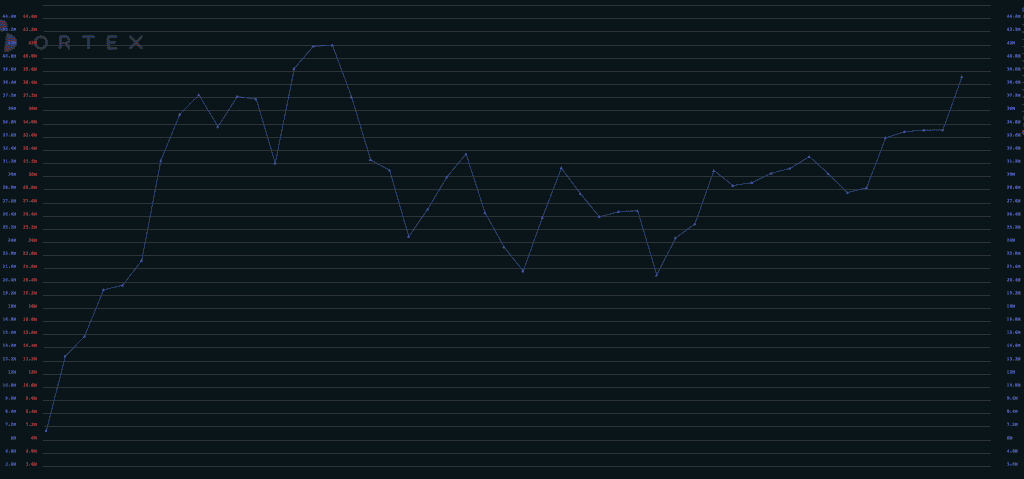
Shares Float: 104,310,000
Current Short Interest: 39,090,000
Short Percent of Float: 37.47%
Short % Increase/Decrease: 14%
Short-selling of Smile Direct stock (SDC) has increased steadily since the start of the year. The latest exchange data shows that shorts total 39,090,00 shares, accounting for 37.47% of the available 104,310,000 float. Typically stocks with short interest higher than 10% are considered prone to a short-squeeze. Therefore, with short interest at 37.47%, Smile Direct exhibits a strong squeeze potential.
Increasing Costs to Short Smile Direct Stock
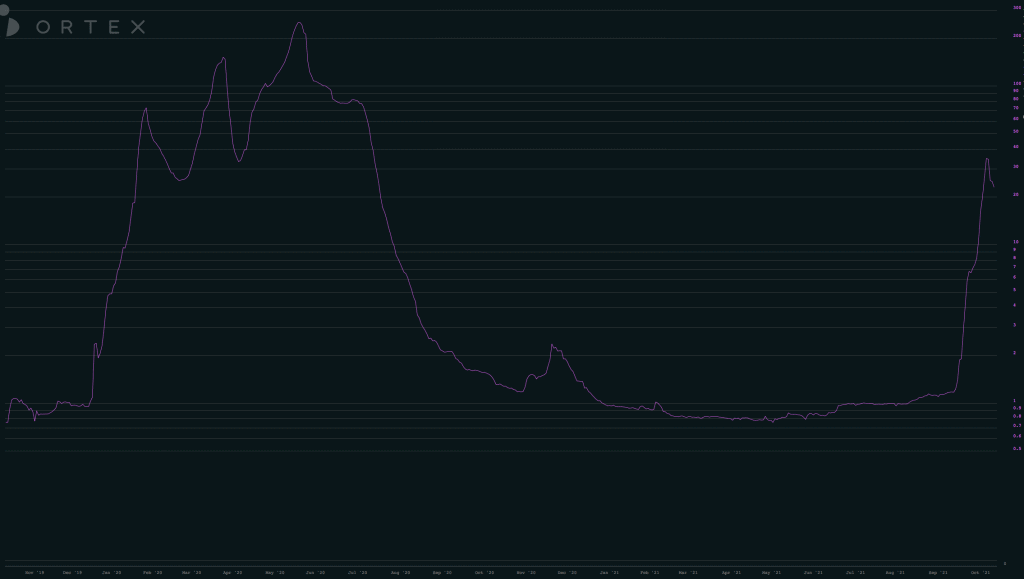
Cost to Borrow: 24.88% Per Annum
7-Day Increase/Decrease: -5.37%
The cost of borrowing SDC stock has risen sharply recently. Currently, lenders of SDC are demanding interest payments set at 24.88% per annum.
Why is this important?
Rising borrowing costs making holding a short position more expensive. Typically, as the short interest increases and less stock becomes available, the cost of borrowing goes up. The rise often forces shorts to cover their positions and return the stock to the lender. This, in turn, drives the price higher still, encouraging more short-covering and triggering the squeeze.
Short Interest, Cost of Borrow, and Price
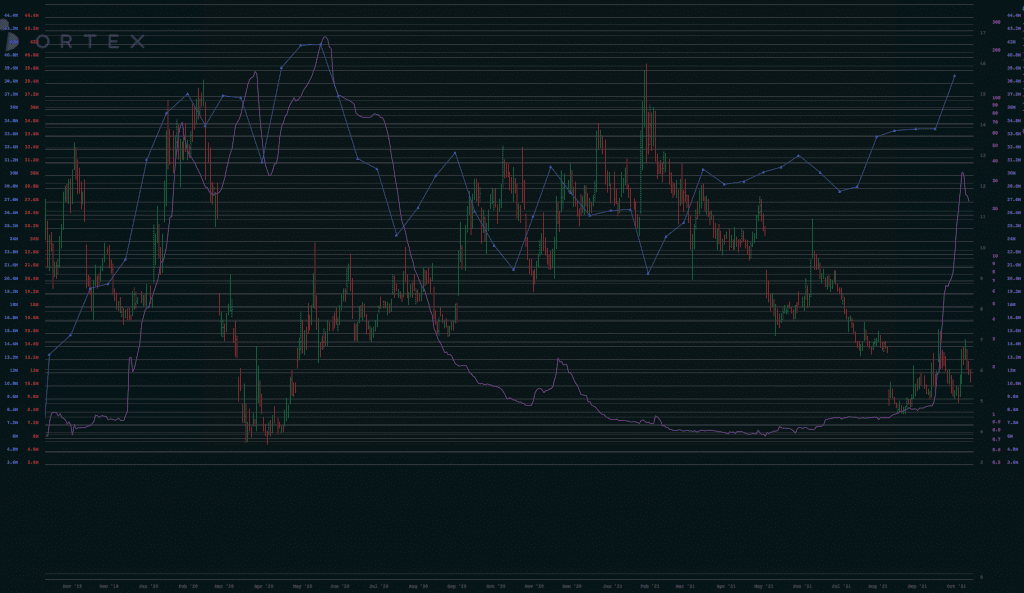
The above chart shows Smile Direct stock reached an all-time low of $3.64 in April 2020, with short interest reaching a record 41,882,856 shares in the same month. The high short interest pushed borrowing costs to a staggering 238% in May. As a result, short-sellers started to unwind their positions, leading to Smile Direct stock surging 180% from April’s low to $10.25 in May.
The current market conditions are similar to April 2020. Smile Direct stock is trading at the lower end of the 52-week range. Furthermore, short interest and borrowing costs have risen dramatically recently, which increases the squeeze potential.
Days to Cover (DTC)
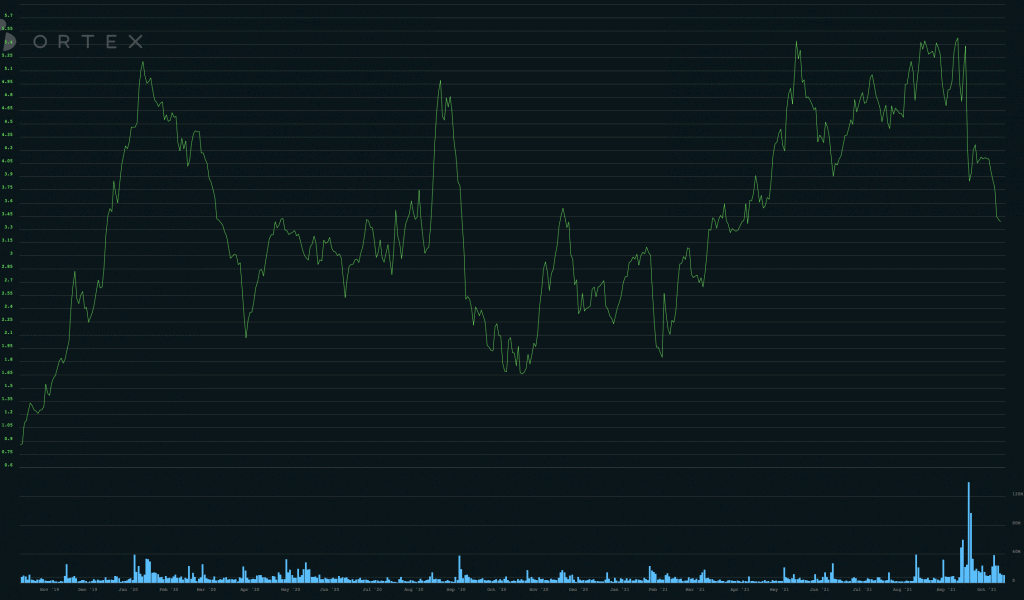
Days to Cover Ratio: 3.35
7-Day Increase/Decrease: -13.7%
‘Days to cover’ calculates the number of days it would take to close the number of shares that have been sold short. The number of shorted shares are then divided by the stocks average daily volume to approximate the number of days needed to cover the short position. A high Days to Cover ratio can often signal a potential for a short squeeze.
As a result of the recent spike in trading volume, the DTC ratio has dropped over the last month. Nonetheless, 3.35 is elevated and supports the squeeze thesis.
Smile Direct Price Analysis
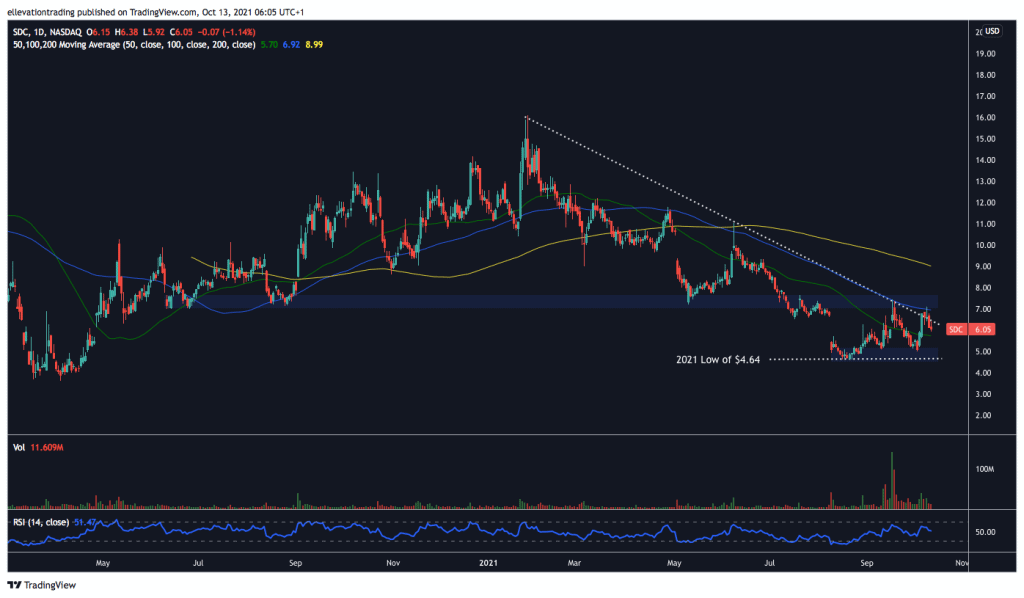
The daily chart shows Smile Direct stock has been trending lower from the January high, resulting in a descending trend capping the price at $6.40. Notably, after a solid start to October, SDC breached the trend line on the 6th. However, the breakout ran into overhead resistance towards the September $7.42 high, topping out at $7.09 and finishing the day below the 100-day moving average (DMA) at $6.92 and back in a downtrend. Subsequently, overcoming the trend and the 100 DMA is essential for the price to gain bullish momentum. Furthermore, failure to clear trend resistance may result in SDC sliding below the 50 DMA at $5.70. In that event, a return to the August low of $4.61 looks likely.
However, if the price climbs above the September high, the bulls may grow in confidence, bringing the 200 DMA at $8.99 into play. Furthermore, if the price closes above the 200 DMA, the stock will be considered to be trending higher, which could encourage short-covering, exaggerating the rally.
For now, the technical analysis suggests the stock may drift lower. Unless the price clears the significant overhead resistance towards $7.40, the path of least resistance is down and not indicative of an imminent price explosion. However, taking into consideration the abnormally high short exposure, dips towards the August low are likely to find willing buyers, as will rallies.
Should you Buy Smile Direct Stock?
Our analysis shows that SDC does have the potential for a short-squeeze. The rising short interest, combined with the high borrowing cost and elevated days to cover ratio, indicate short-sellers are under increasing stress. However, the current technical outlook is unclear.
That being said, the GameStop squeeze at the start of the year was several months in the making. GME stock first started to gain traction on WallStreetBets in August 2020 when trading around $4.00. However, it wasn’t until January 2021 that the squeeze took hold, and GME surged 1200% to $483. Therefore, investors should remember that even if the data lends weight to a short-squeeze, it may not develop for quite some time. Furthermore, just because the stock is heavily short doesn’t guarantee it’s worth buying. Short-sellers, particularly hedge funds, are professional investors and incredibly well-informed. On that basis, the stock may be overvalued at the current price.
Conclusion
Smile Direct Stock (SDC) is a strong candidate for a short-squeeze based on the above data. However, this view is based purely on the short interest analysis and not indicative of improving business conditions. Buying a stock because of its high concentration of shorts is inherently risky, and therefore only suitable for professional investors prepared to lose some or all of their investment. However, for traders with a high-risk tolerance looking for a short-squeeze target, SDC could provide an interesting opportunity.
For more market insights, follow Elliott on Twitter.

